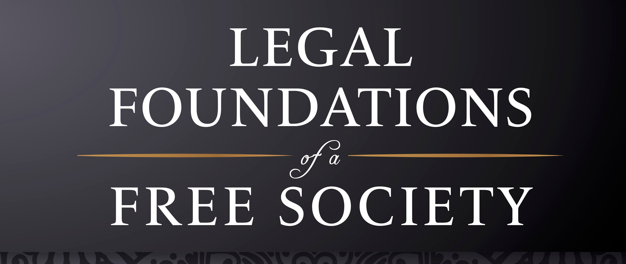
Foreword: Legal Foundations of a Free Society
[This article is the foreword to Stephan Kinsella’s, Legal Foundations of a Free Society (Houston, Texas: Papinian Press, 2023)]
The question as to what is justice and what constitutes a just society is as old as philosophy itself. Indeed, it arises in everyday life even long before any systematic philosophizing is to begin.
All throughout intellectual history, one prominent answer to this question has been to say that it is “might” that makes “right.” Or more specifically: that what is right or wrong, just or unjust, is unilaterally decreed by a State qua territorial monopolist of violence. The self-contradictory nature of this “decisionist” position, i.e. of “legal positivism,” comes to light once we ask its proponents for a reason or evidence as to why we should believe the proposition that “might makes right” to be true and correct. By virtue of providing any such reason or evidence, however, and thus seeking—ultimately—unanimous agreement regarding the validity of the proposition in question, any such proponent implicitly acknowledges the presence of other reasonable and sensible persons and, importantly, that the question of right or wrong, true or not-true, then, is not a matter of “might” or “fiat,” but a question to be decided on the basis of common reason and experience instead. Yet reason and experience demonstrate, contrary to the proponent’s initial claim, that “might does not make right.” That “might is might” and “right is right,” but “no might can ever make a right.”
Aside from the decisionism championed by legal positivists, the most prominent answer in modern times to the question under consideration, then, has come from so-called social-contracts theorists. According to them, what is just or not is determined by the terms of a contract concluded and agreed upon by all members of a society. — Yet this solution opens more questions than it answers and ends in a tangle of confusion. For one, no such contract has ever been concluded anywhere. Yet in the absence of any such contract, would people still be able to distinguish between right and wrong? Obviously, one would think so, because otherwise they would not even be able to rightfully conclude a—indeed any—valid contract. Put differently: there first must be a contractor—a person—and then there must be something rightfully owned and to be contracted by this person—private or personal property—before there can ever be a valid contractual agreement. Thus, personhood and private property logically—or more precisely: praxeologically—precede contracts and contractual agreements; and hence, trying to construct a theory of justice on the foundation of contracts is a fundamental praxeological error.
Moreover, with personhood and private property as the praxeological foundation of contracts, then, any universal, all-encompassing and -including social contract as imagined by social-contract theorists is impossible. Rather: on this basis, all contracts are contracts between identifiable and enumerable persons and concerning identifiable and enumerable things or matters. No contract can bind anyone other than the actual contractors, and no contract can concern things or matters other than those specified in the contract. Accordingly: Real persons with their various real, separate and exclusive properties simply cannot—praxeologically cannot—conclude a contract as fancied by social contract theorists.
For such a contract to be conceivable, a “new person” must be invented. A fictitious person, that can do what no real person can! This “new person,” invented for the purpose by social contract theorists, then, is invariably some wildly unrealistic, severely “dis-embodied” entity, i.e., a person without any bodily needs or appetites; “pure” reason, if you will, freed from all constraints of time and place. — The theorists then ask what arrangement of the world such persons would agree on as just. And they then spin out an answer as to what they believe this agreement between such entities to be, and why. — Any such answer, however, whatever it may be, is always arbitrary, because the only thing that can possibly be known about fictitious people and an agreement among them is whatever has already been invested in such beings from the very outset, per assumption. Indeed, as John Rawls, the most celebrated modern social contract theorist has admitted with captivating frankness, he had simply “define(d) the original position [of fictitious people placed behind a ‘veil of ignorance,’ HHH] so that we get the desired solution.”1 While the results that Rawls gets from his assumptions concerning the original position agree largely with the political views of the social democratic left, other social contract theorists, with different assumptions about the original meeting-of-the-minds, such as James M. Buchanan and his fictitious constructs of “conceptual contracts” and “quasi-unanimity,” for instance, have proposed answers more closely associated with the political right. Still other theorists have presented yet other results. Demonstrating, then, that the intellectual endeavors of social contract theorists, however ambitious and sophisticated they may appear, are ultimately no more than idle mental exercises: deriving wildly unrealistic conclusions from wildly unrealistic assumptions, i.e., examples of “garbage-in-and-garbage-out.”
But there is another, more sinister aspect to the idea of a social contract that comes to light once anyone of the various contractual agreements as fancied by social contract theorists is actually put to the test, implemented and enforced. Because implementing and enforcing the terms of a contract that no real person had or could have agreed on means, in effect, that all real contracts between real people are superseded and replaced by the terms of some alleged agreement among fictitious people as the ultimate judge in matters of right and wrong. The word “contract,” then, with its positive connotations, is used by social contract theorists to advance a program that is actually destructive of all contracts. They declare non-contracts and non-agreements to be contracts and agreements and contracts and agreements to be non-contracts and non-agreements. — Thus, ultimately, social contract theory turns out barely less arbitrary than the decisionism of legal positivists. For its proponents, the question of right or wrong may not be considered a matter of mere decree as for some strict positivists. Instead, for them, it is the intuitions and fancies of some philosophers that are supposed to do the job. But this is hardly less arbitrary, one would think! And, of course, since no real person had or could have agreed to any so-called social contract, its enforcement then always requires an agency not itself founded on agreement and contract, but on disagreement, violence and coercion instead: a State. And just like legal positivists, then, social contract theorists invariably turn out to be statists, too, assigning and entrusting the role of the ultimate arbiter of right and wrong to the State qua territorial monopolist of violence.
Another popular answer to the question under consideration is that of utilitarianism. Utilitarians essentially contend that the very rules that maximize or promise to maximize total social utility or bring about the greatest happiness to the greatest number of people are and should be considered just. Apart from other difficulties connected with its consequentialism, however, this answer can be quickly dismissed as fatally flawed for the simple reason that there exist no units of utility or happiness; and hence, that any interpersonal comparison of utility or happiness and any aggregation of individual utility or happiness to “social utility” or “social happiness” must be considered impossible (or, if still invoked, as entirely arbitrary).
With the answers of legal positivists, social contract theorists and utilitarians all rejected as fundamentally flawed, however popular they may be, the only remaining answer, then, comes from the old, pre-modern intellectual tradition of natural law and natural rights. It is also in this nowadays rather unfashionable intellectual tradition, broadly conceived, that Stephan Kinsella’s here presented work must be placed.
Natural law and rights theorists contend that the principles of just human conduct can be discovered from the study of human nature. On the one hand, such study reveals that humans are endowed with reason, as manifested by the indisputable fact that they can speak and communicate with one another, from person to person, in a common language. On the other hand, this study shows that humans are also actors (and in combination then: reasonable actors). Speaking and communicating itself are purposeful activities directed at a goal. Yet even if and when we are not speaking or communicating but do things silently, we are still acting and cannot but act as long as we are not asleep, comatose or dead.
Further, this study also reveals the “deep structure” of human action, i.e. what all actions of all humans have in common. Every individual actor (and only individuals act!), whatever he does, pursues a goal or end the attainment of which he considers more satisfying than the satisfaction to be expected from acting differently. Every actor is thereby placed in a given environment, at a specific point in time and space, with specific external surroundings of men and materials, and equipped with his own nature-given bodily makeup and mental endowment; and every action, then, whatever it may be, invariably aims to alter an actor’s specific present situation to his personal advantage and greater satisfaction. In any case, to reach his goals, whatever they may be, an actor invariably must employ means. At a minimum, he must employ his own physical body and brain (plus the body’s standing room) as means for the attainment of some expected bodily or psychic gain, and he must thereby use up some time that he also could have used differently.
Generally, however, a person’s actions involve more than the purposeful use of one’s physical body and mind. It involves also various elements of the external world that, unlike a person’s own body, can only be indirectly controlled, by means of one’s directly controlled body. Such elements of the external world that can be indirectly controlled and manipulated by a person and that are recognized or believed by an actor to be suitable for the attainment of his ends are called means. Those elements of the external world beyond or believed to be beyond human control on the other hand are referred to as external conditions under which a person’s actions are to take place. The choice of means employed by a person for the attainment of his ends is always a matter of ideas, i.e. of reason and reasoning. An actor always chooses such an allocation and arrangement of means that he believes to bring about some desired result. The choice of means is validated by their result. A person’s actions then are always guided by some ideas about cause and effect: performing A, B and C will lead to X, Y and Z. But man is not infallible and a person’s ideas concerning cause and effect or the interconnectedness and regularity of events may be false, and a person’s action based on these ideas then will lead to failure rather than the anticipated success, inducing the person to learn, i.e. to revisit and possibly revise his original ideas.
Given this insight into the general human condition it becomes immediately clear what a human ethic or a theory of justice worth its salt must accomplish. It must give an answer to the question of what am I and what is every other person permitted (or not permitted) to do, right now and right here, wherever a person may find himself and whatever his external surroundings of men and materials may be. More specifically, what is a person permitted (or not permitted) to do in an interaction with another person? And: what external entities is a person permitted (or not permitted) to bring under his control to be used as means toward his personal ends?
Because no person can ever stop acting, from his beginnings as a person until his very end (except when asleep, comatose or dead), these questions arise again and again, without end, for everyone, wherever and whenever he may find himself and must act. Obviously, then, an answer to pressing questions such as these cannot wait for the establishment of the institution of a State, the conclusion of a contract (which would actually have to presuppose a valid answer to these very questions in order to make it a valid contract) or the arrival of some future consequences. Instead, the answer must be discoverable and recognizable from the very outset, from the first, immediate insight into the nature of man as a reasonable actor. And indeed, this is so once the purpose, the ultimate end, of all reason and reasoning is recognized and acknowledged. As already noted, human reason is manifested in the indisputable fact that one person can communicate with another person in a common language (and different languages are inter-translatable). The purpose of speaking and communicating with one another, then, even if and when expressing one’s disagreement with another person’s say-so in meaningful words, is to guide or coordinate the actions of different persons by words or meaningful symbols alone. This endeavor may succeed and words help guide or coordinate the actions of different persons to mutual satisfaction. Or the endeavor may fail. But in any case, the goal of speaking and communicating is always and invariably the same: to maintain peace and seek peaceful cooperation or coexistence—and in reverse: to avoid conflict, i.e., physical clashes or conflagrations of people that are destined to result whenever and wherever two or more people pursue their own different goals with the help of one and the same person’s body or one and the same indirectly controlled or controllable external means of action at the same time.
The objective for a human ethic or a theory of justice, then, is the discovery of such rules of human conduct that make it possible for a—indeed, any—bodily person to act—indeed, to live his entire active life—in a world made up of different people, a “given” external, material environment, and various scarce—rivalrous, contestable or conflict-able—material objects useable as means toward a person’s ends, without ever running into physical clashes with anybody else.
Essentially, these rules have been known and recognized since eternity. They consist of three principal components. First, personhood and self-ownership: Each person owns—exclusively controls—his physical body that only he and no one else can control directly (any control over another person’s body, by contrast, is invariably an in-direct control, presupposing the prior direct control of one’s own body). Otherwise, if body-ownership were assigned to some indirect body-controller, conflict would become unavoidable as the direct body-controller cannot give up the direct control over his body as long as he is alive. Accordingly, any physical interference with another person’s body must be consensual, invited and agreed to by such a person, and any non-consensual interference with his body constitutes an unjust and prohibited invasion.
Second, private property and original appropriation: Logically, what is required to avoid all conflict regarding external material objects used or usable as means of action, i.e. as goods, is clear: every good must always and at all times be owned privately, i.e. controlled exclusively by some specified person. The purposes of different actors then may be as different as can be, and yet no conflict will arise so long as their respective actions involve exclusively the use of their own private property. And how can external objects become private property in the first place without leading to conflict? To avoid conflict from the very start, it is necessary that private property be founded through acts of original appropriation, because only through actions, taking place in time and space, can an objective—intersubjectively ascertainable—link be established between a particular person and a particular object. And only the first appropriator of a previously unappropriated thing can acquire this thing as his property without conflict. For, by definition, as the first appropriator he cannot have run into conflict with anyone else in appropriating the good in question, as everyone else appeared on the scene only later. Otherwise, if exclusive control is assigned instead to some late-comers, conflict is not avoided but contrary to the very purpose of reason made unavoidable and permanent.
Third, exchange and contract: Other than per original appropriation, property can only be acquired by means of a voluntary—mutually agreed upon—exchange of property from some previous owner to some later owner. This transfer of property from a prior to a later owner can either take the form of a direct or “spot” exchange, which may be bi- or multi-lateral as when someone’s apples are exchanged for another’s oranges, or it may be unilateral as when a person makes a gift to someone else or when someone pays another person with his property now, on the spot, in the expectation of some future services on the part of the recipient. Or else the transfer of property can take the form of contracts concerning not just present but in particular also prospective, future-dated transfers of property titles. These contractual transfers of property titles can be unconditional or conditional transfers, and they too can involve bi- or multi-lateral as well as unilateral property transfers. Any acquisition of property other than through original appropriation or voluntary or contractual exchange and transfer from a previous to a later owner is unjust and prohibited by reason. (Of course, in addition to these normal property acquisition rules, property can also be transferred from an aggressor to his victim as rectification for a previous trespass committed.)
Drawing on the long, but in today’s world largely forgotten or neglected intellectual tradition of natural law and natural rights theory with its three just briefly sketched principal components, then, the most elaborate, systematic, rigorous and lucid presentation of a theory of justice up until then had been developed in the course of the second half of the 20th century by economist-philosopher Murray N. Rothbard, culminating in his Ethics of Liberty, originally published in 1982. Unfortunately, but not entirely surprisingly, however, his work was typically either completely ignored or else dismissed out of hand by the gatekeepers and high priests of academia. The anarchist conclusions ultimately arrived at by Rothbard in his works appeared simply outlandish in an ideological environment molded overwhelmingly by tax-funded intellectuals and steeped to the hip in statism or étatisme. Among academic big-shots, only Harvard philosopher Robert Nozick in his Anarchy, State and Utopia acknowledged his intellectual debt to Rothbard and seriously tried to refute his anarchist conclusions—but miserably failed.
While Rothbard’s work largely fell on deaf ears within academia, then, it exerted considerable influence outside of it, in the public at large. Indeed, through his work Rothbard became the founder of the modern libertarian movement, attracting a sizable popular following far exceeding that of any mainstream academic in numbers. As for the further development of a natural-law and -rights based theory of justice, however, this very success turned out to be a rather mixed blessing. On the one hand, the movement inspired by Rothbard likely helped dampen and slow down the popularity and growth of statism, but it manifestly failed in halting or even reversing the long-run historical trend toward ever increasing state-power. On the other hand (and that may well be one of the reasons for this failure), the larger the movement grew in numbers, the greater also the confusion and the number of intellectual errors spread and committed by its followers. The pure theory of justice as presented by Rothbard was increasingly watered down, misunderstood, misinterpreted or downright falsified, whether for short-run tactical gains, out of ignorance or plain cowardice. As well, all too often sight was lost of the fundamentally important distinction between the core, the foundational principles of a theory on the one hand and its application to various peripheral—often far-fetched or merely fictional—practical problems on the other; and far too much effort and time, then, has been spent on debating peripheral issues the solution of which may well be arguable, but which is of minor importance in the larger scheme of things and helps distract public attention and concentration away from those questions and issues that truly matter and count.
In this situation, then, more than 40 years after the first publication of Rothbard’s Ethics of Liberty and characterized by much practical disappointment and increasing theoretical confusion, the publication of Stephan Kinsella’s present work must be considered a most welcome sign of renewed hope and new, refreshing intellectual inspiration. Indeed, with this work, that has been in the making for more than two decades, Kinsella has produced no less than an intellectual landmark, establishing himself as the leading legal theorist and the foremost libertarian thinker of his generation. While following in Rothbard’s footsteps, Kinsella’s work does not merely rehash what has been said or written before. Rather, having absorbed as well all of the relevant literature that has appeared during the last few decades since Rothbard’s passing, Kinsella in the following offers some fresh perspectives and an innovative approach to the age-old quest for justice, and he adds several highly significant refinements and improvements and some centrally important new insights to the theories of personhood, property and contract, most famously some radical criticism and rejection of the idea of “intellectual property” and “intellectual property rights.”
Henceforth, then, all essential studies in the philosophy of law and the field of legal theory will have to take full account of the theories and criticisms expounded by Kinsella.
1. John Rawls, A Theory of Justice, revised ed. (Cambridge, Mass.: Harvard University Press, 1999), p. 122.



